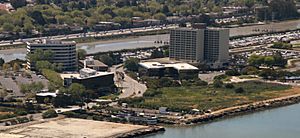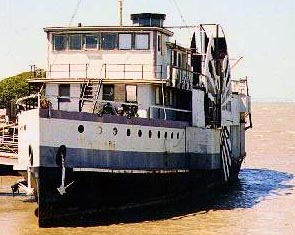USAT General Frank M. Coxe facts for kids
Quick facts for kids History |
|
|---|---|
| United States | |
| Name | General Frank M. Coxe |
| Builder | Charles Ward Engineering Works, Charleston, West Virginia |
| Laid down | 16 July 1921 |
| Launched | 3 March 1922 |
| Acquired | delivered 1 December 1922 |
| Decommissioned | 1947 |
| Fate | Sold and became a harbor tour boat and finally a floating restaurant, scrappped 2020 |
| General characteristics | |
| Type | Troop ferry |
| Tonnage |
|
| Displacement | 900 long tons (914 t) |
| Length | 144 ft (44 m) (LBP) |
| Beam | 28 ft (8.5 m) |
| Depth | 9 ft (2.7 m) |
| Propulsion | 2 Ward water tube boilers |
The General Frank M. Coxe was a special kind of ferry boat. It was built for the United States Army to carry people and supplies. This ship helped connect different military bases around California's San Francisco Bay. From 1932 through World War II and the Korean War, all Army ships and facilities in the bay were managed by the San Francisco Port of Embarkation.
This 144-foot (44 m) long ship was started on July 16, 1921. It was launched on March 3, 1922, and delivered to the War Department on December 1, 1922. It was built by Charles Ward Engineering Works. The Coxe and its sister ship, the USAT General John McE. Hyde, were designed after World War I. They were made to transport Army staff to island bases in important harbors. This was because Pacific ports were becoming more important for the military.
Before the big bridges and highways were built in San Francisco Bay, moving around by water was super important. It's thought that the General Frank M. Coxe carried about six million passengers during its time in the military!
Contents
Building the Coxe
The Coxe was an Army ship, not a Navy one. The US Army owned and operated thousands of ships like it for specific jobs. The ship was designed by a famous New York company called Cox & Stevens. They were known for designing yachts and smaller commercial and military boats.
The Coxe was built in 1922 by Charles Ward Engineering Works in Charleston, West Virginia. This company was good at building ships that could sail in shallow water, like ferries and riverboats. The Coxe's sister ship, the General John McE. Hyde, was built a year earlier. (Sadly, the Hyde was sunk by Japanese forces in 1942 during World War II.)
A Look at Its History
Serving the Military
The Coxe was an active military ship in San Francisco Bay from 1922 until 1947. It was taken out of service and sold after World War II ended.
Before the Golden Gate Bridge and Bay Bridge were built in the mid-1930s, it was hard to travel by land around the Bay Area. The Bay and its rivers split up the region. But the Army had many people stationed at forts and facilities all around the Bay. These included places like Fort Point and Fort Cronkite, and even island forts like Fort McDowell on Angel Island and Alcatraz.
By the 1920s, Angel Island and Alcatraz were no longer needed as artillery forts. Their jobs changed. Angel Island became a place to process new soldiers. Alcatraz became a super-secure military prison. The Coxe regularly traveled between Fort Mason (on the San Francisco peninsula) and Fort McDowell (on Angel Island). It also made stops at Alcatraz. The ship continued to serve Alcatraz even after the Army gave control of the prison to the Federal Prison Bureau in the mid-1930s.
The Alcatraz Escape Attempt
In 1935, a prisoner named John K. Giles tried to escape from Alcatraz. He was 50 years old and had been in trouble before. Giles stole an Army uniform from the prison laundry. He then snuck onto the Coxe just before it left for Angel Island.
Prison officials quickly realized someone was missing. But a mistake in communication and some fake documents helped Giles get off the ship at Fort McDowell. However, an officer noticed something odd about his uniform. The officer then saw his fake documents and arrested him. The officer didn't even know about the prison escape attempt at first! Giles was sent back to Alcatraz to finish his sentence.
There was some debate about whether this was a successful escape and recapture, or if the plan was simply stopped. Officially, Alcatraz kept its perfect record of being "escape proof" until it closed in the mid-1960s. This was because all other missing prisoners were thought to have drowned.
World War II Service
After 1932, Fort McDowell became a key place for processing US troops. These soldiers were heading to the Pacific during World War II. Many troops were processed at both Fort McDowell and Fort Mason. Even with the new bridges, ships and ferries were the only way to connect these places.
During World War II, the Coxe made up to eight trips a day. It traveled between Fort McDowell and Fort Mason. After a huge troop staging area called Camp Stoneman opened in 1942, Fort McDowell continued to process soldiers and hold prisoners of war. After the war, Fort McDowell was slowly closed down. By 1947, the Coxe was no longer needed by the military and was taken out of service.
Life After the Military
A Tour Boat
After its military service, the Coxe was bought by the Golden Gate Scenic Steamship Line. This company now runs the Red & White Fleet of ferry and tour boats in San Francisco Bay. The Coxe was renamed SS Frank M. Coxe and became a local cruise and tour boat. It operated this way until the 1950s.
A Floating Restaurant

After it stopped being an active boat, the Coxe was turned into a floating restaurant. It was called the Showboat and was located in Stockton, California. The restaurant changed owners and names several times. At one point, it was even a dance club for young people under 21.
In the 1960s and 1970s, it was docked at Jack London Square in Oakland, California. Then it moved to Burlingame, California. There, it became a Thai restaurant called Pattaya Princess in the 1970s and 1980s. It closed in 1990.
Its Final Years
From 1990 until 2006, the General Frank M. Coxe was an empty ship. It was docked in Burlingame, California, near San Francisco International Airport. Then, some local restaurant owners bought the ship. They bought it from Mr. Robert Sherman, who had owned it before.
The new owners got a long-term lease from the City of Burlingame. They fixed up the ship. They changed its name from General Frank M. Coxe to The Sherman, to honor the previous owner. It then operated as a restaurant with that name.
In 2008, the owner took out a loan to repair the ship. But they couldn't pay back the loan, and The Sherman went into foreclosure. The State Lands Commission, which owned the land where the ship was docked, asked for the vessel to be moved. So, on June 15, 2014, The Sherman (or Coxe) was moved from Burlingame. It was towed to the Stockton Marina.
Later, The Sherman was towed to Mare Island Naval Shipyard in Vallejo, California. There, it was taken apart for scrap metal. This work was finished on January 10, 2020.


